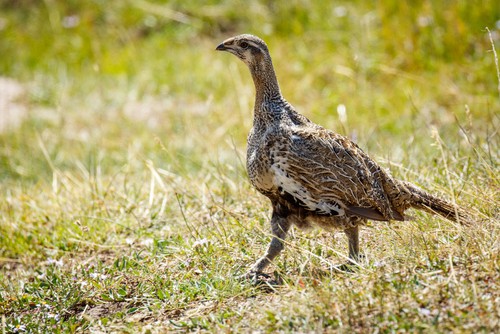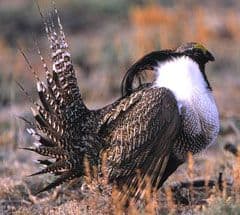What are sage grouse?
The sage grouse is the largest grouse in North America. There are two closely related but distinct species, the Greater Sage Grouse (Centrocercus urophasianus) and the Gunnison Sage Grouse( Centrocercus minimus). We collectively call both species sage grouse. They live in the western United States and southwestern Canada. Scientists designated the Gunnison Sage Grouse as a separate species from the Greater sage Grouse in 2000. Before this, the last time a new bird species was discovered in the U.S was in the 1800s.
What do sage grouse look like?


Greater Sage Grouse (Centrocercus urophasianus)
Both male and female greater sage grouse are mottled grey-brown. They have dark brown, pointed tails, and their legs are covered with feathers down to their toes.
Adult males are grey along their backs and up the back of their necks. They have a yellow comb above each eye and a yellow air sac on each side of their throat that they inflate when putting on a mating display for the females. The color of their throat is dark brown, their breasts are white, and their bellies are black.
Adult females are mottled gray-brown with a light brown throat and dark brown belly.
Adult male greater sage grouse are large birds. They range between 24 and 30 inches in length and weigh between 4 and 7 pounds. On the other hand, adult females of the species are 25% smaller than males in length and 36% smaller than males in weight on average. Source

Gunnison Sage Grouse (Centrocercus minimus)
Gunnison Sage Grouse look very similar to Greater Sage Grouse. However, they’re about 1/3 smaller in size. Source Additionally, the plumage on male Gunnison Sage Grouse, is slightly different than that on male Greater Sage Grouse. They have white barring on their tail feathers. Besides that, they have long dark feathers on the back of their necks that poke out when they’re on mating display and give the appearance of a ponytail.
Female Gunnison sage grouse look almost identical to female greater sage grouse except that they are about 1/3 smaller.
Sage Grouse Range; Where Do Sage Grouse Live?
Greater Sage Grouse
Greater Sage Grouse require habitats of large unbroken tracts of sagebrush. Consequently, they live in the sagebrush country of the western United States and Canada.
According to the U.S Fish And Wildlife website, there are somewhere between 200,000 and 500,000 greater sage grouse in the wild. They live in 11 U.S states which are North Dakota, South Dakota, Colorado, Wyoming, Utah, Montana, Idaho, Nevada, California, Oregon, and Washington.
Additionally, there are a small number of greater sage grouse in Canada. They live in southwestern Saskatchewan and southeastern Alberta. There were formerly Greater Sage Grouse in the Okanogan Valley of British Columbia. However, that population is extinct.
In 2012 the Canadian Government determined that there were only 40 to 60 adult greater sage grouse in Alberta and 55 to 80 adult birds in Saskatchewan. Consequently, the Canadian environmental ministry issued an emergency protective order to preserve the remaining Greater Sage Grouse population in that country. The order puts strict limitations on industrial (mostly oilfield) activity within the confines of the Greater Sage Grouses remaining habitat.
Gunnison Sage Grouse
Like Greater Sage Grouse, Gunnison Sage Grouse need large unbroken tracts of sagebrush to exist in their habitats.
Gunnison sage grouse live exclusively south of the Colorado River in southwestern Colorado and southeastern Utah. There are only 4,000 to 5,000 birds in existence, with the majority of their population centered in the Gunnison Basin of Colorado.
Their range is fragmented into 8 distinct population areas, consisting of land in Delta, Dolores, Gunnison, Hinsdale, Mesa, Montrose, Ouray, Saguache, and San Miguel Counties in Colorado. The Utah population lives in Grand and San Juan Counties.
Sage Grouse Behavior
Mating Behavior
Sage Grouse are famous for their courtship rituals which are called lekking. Starting early March, male sage grouse or cocks will assemble on breeding grounds called leks each day. In general, they’ll use an open area that is close to sagebrush cover to do their lekking. What’s more, they’ll use the same sites every year.
They showcase themselves to prospective mates for several hours in the early morning and late afternoon. When doing this, they fan their feathers, strut, and make loud popping noises with the air sacks in their throats.
All this trouble that they go through is to gain the attention and win the favor of any female sage grouse or hens in the area.
Hen grouse go to the leks to select the fittest cock to mate with. Generally, only a couple of dominant birds from each lek get to do the mating. The others put on a show for nothing.
After mating, the cock has no further contact with the hen. She will take care of the nesting duties and rear the chicks on her own.
Nesting Behavior
After the hen has successfully mated, she’ll head to the nesting grounds, which are generally close to the lek. She will build a nest within 7 to ten days after mating.
Sage grouse are ground nesters. They usually make their nest beneath the cover of sagebrush or some thick grass. Their nests are approximately 8 inches across and between 2 and 4 inches deep and lined with leaves, grass, and feathers that the hen plucks from her breast.
Their average clutch size is around 7 eggs, and their incubation period is about 27 days.
Sage grouse chicks can feed themselves within minutes after hatching. Additionally, they can fly for short distances after 5 days. They’ll be able to fly strongly after about 10 weeks.
What do sage grouse eat?
Sage grouse don’t have a muscular crop, so they cant grind seeds. Their diet mainly consists of succulent leaves, grasses, and forbs, along with insects. Of the items mentioned above, sagebrush leaves and buds take up the largest percentage of their menu. In the fall and winter, they live almost entirely on sagebrush.
Sage grouse chicks predominantly eat insects for the first week of their life. After that, their diet gradually switches over to a greater percentage of plant material.
Sage Grouse Predators
Sage grouse have a long list of predators. Coyotes, bobcats, and feral dogs are threats from the ground. Additionally, hawks, falcons, and eagles are all air-borne threats.
When grouse are on their Lek grounds, they have to keep an especially cautious eye to the sky, looking for golden eagles.
Badgers, skunks, snakes, weasels, raccoons, and ravens are all a threat to rob sage grouse nests.
Environmental Threats To Sage Grouse
Sage Grouse need large unbroken tracts of sagebrush habitat to survive. Consequently, anything that disturbs the continuity of these large sagebrush steeps is bad for Sage Grouse. This includes road building, oilfield exploration, overgrazing by feral horses, range fires, and poisoning sagebrush stands to improve range for cattle grazing.
Also see: Ring-Necked Pheasant – Krebs Creek
Chukar Partridge – Krebs Creek
Facts About Ptarmigan – Krebs Creek
Recent Posts
The only venomous snakes in Washington State are Northern Pacific Rattlesnakes. The Northern Pacific Rattlesnake (Crotalus oreganus oreganus) is a sub-species of the Western Rattlesnake. Anyone...
Skunks are not classified as true hibernators. But they go into a state of torpor when the weather gets cold. Skunks are light sleep hibernators, along with opossums, bears, and raccoons. ...
